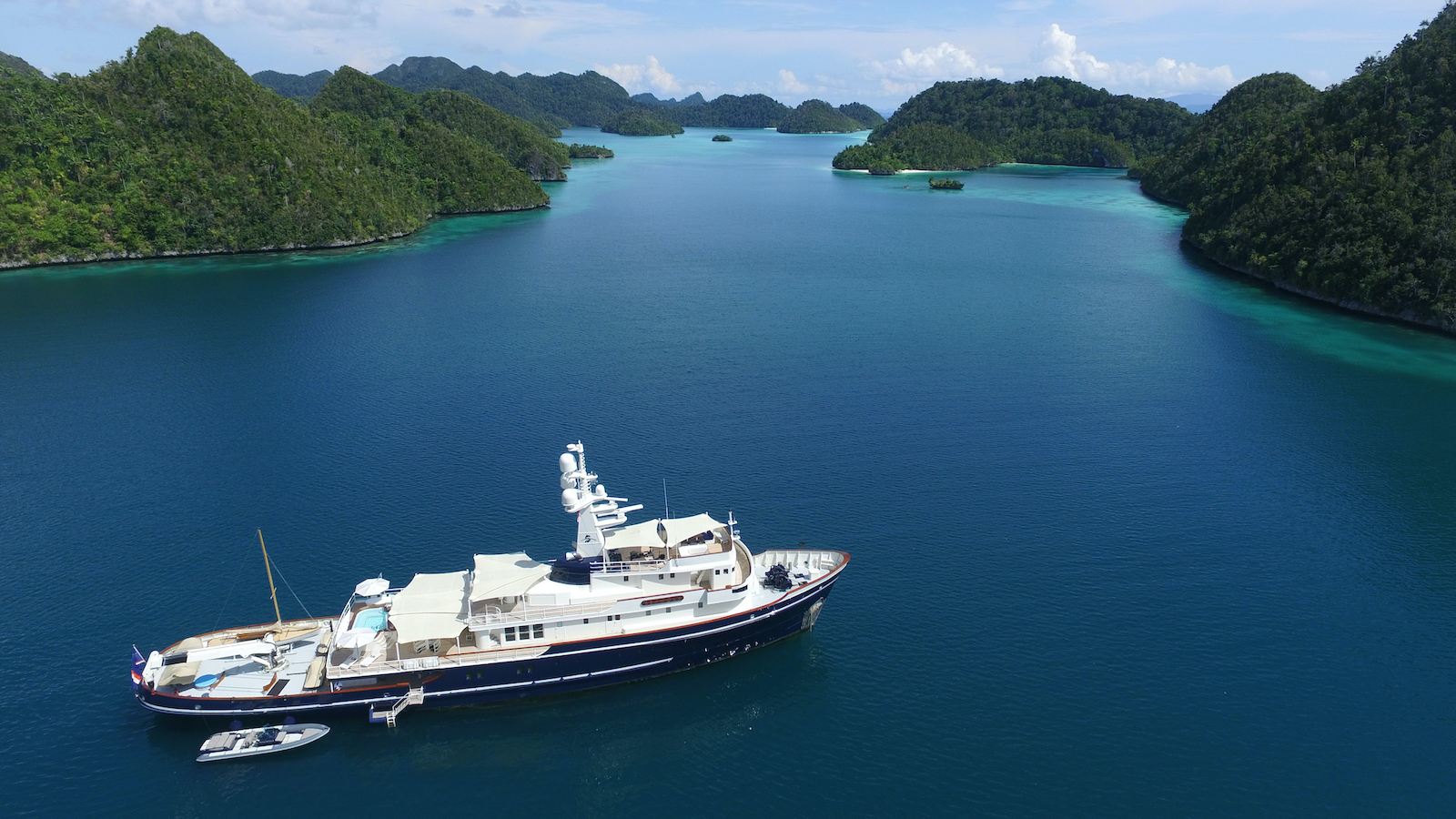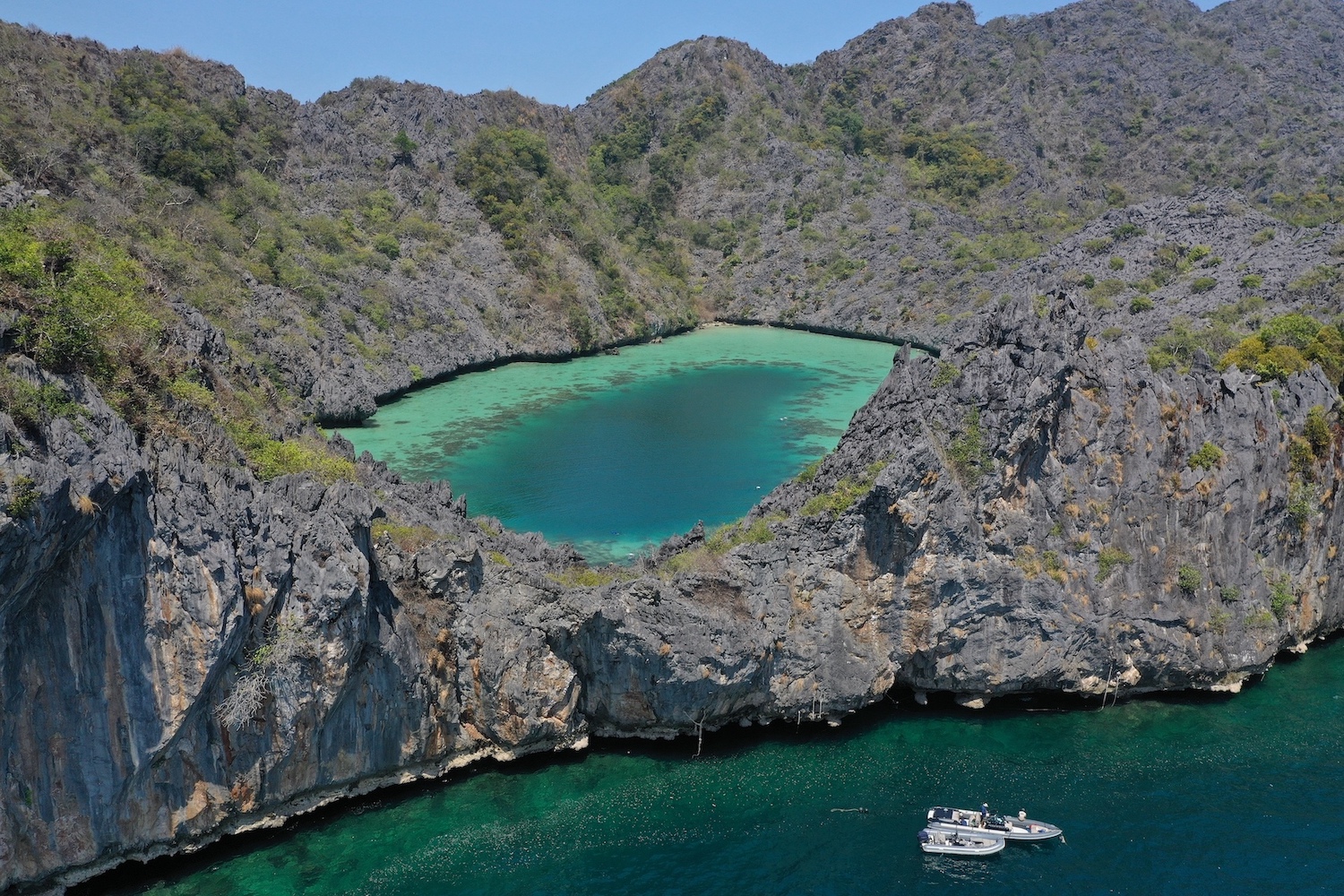- CAPTAIN'S LOG / Asia
- 3 December 2019
PART OF THE CORAL TRIANGLE, Raja Ampat’s magnificent biodiversity is believed to repopulate the reefs of the South Pacific and Indian Ocean via the deep sea currents that funnel through this superb cruising ground.
But it’s not all about the diving as guests can also kayak and swim through blue lagoons, explore caves on steep limestone islands, and meet the locals in friendly Papuan villages.
Above the surface lies 1,500 tropical islands and islets covered in lush jungle, rimmed with white sand and coconut palms waving against a humid blue sky. Bird of paradise stalk through the underbrush, dancing proudly for a mate, and the monkey-like marsupial, the Waigeou-spotted cuscus, watches from the canopy.
Under the water, the world goes technicolour with spectacular coral formations, dazzling shoals of fish, caves as big as cathedrals, and giant clams littering the seabed. Whale sharks move slowly through sunlit waters, manta rays fly by with infinite grace, and pygmy seahorses hide in the sea fans as a wobbegong shark shuffles by.
You do not have to swim to the sea life in Raja Ampat – you are immersed in it at every turn.
Below are some of the most spectacular places we visited on M/Y Seawolf while cruising Raja Ampat, from the perfect beach for a guest barbecue to sensational dive spots and friendly villages.
Pef Island
The entrance to this stunning anchorage is the southern channel between Pef and the larger island of Gam. Although the entrance is narrow, there was plenty of depth and more than enough swing room for the 59-metre Seawolf once inside. We had the drone up on approach and were rewarded with great aerial shots of the yacht among the many limestone islets that speckle the bay.
Once we anchored, the kayaks, paddleboards and owner’s rowboat were the first of the toys to hit the water as there were endless small lagoons, caves and channels to explore. When the guests returned from their paddling adventure, the dive tender was loaded and ready to go. On the seaward side of Pef Island, we found a number of easy dive or snorkel sites in crystal clear water.
Mike, our excellent cruising guide from our shore support team at The Lighthouse Consultancy, chose a site called Mayhem. It didn’t disappoint – the guests returned raving about the dive and the incredible number of wobbegong sharks they had seen.
Miosmengkara
Although Raja Ampat is sparsely populated, the group of islands around Miosmengkara have a number of friendly Papuan villages.
Before the tender even hit the water, there were a couple of kids in dugout canoes who came out to say hello. With the guests aboard the tender and the kids acting as pilots with their canoes, we made our way through the reef to the village dock.
By the time we arrived, a large welcoming party of what seemed like half the village was waiting for us.
A stroll around the village accompanied by the village head was a great insight into the daily lives of this small fishing community.
Wofoh Island
Actually two small islands joined by a shallow reef, Wofoh was the perfect spot for a beach barbecue.
While the crew were setting up for dinner on the beach, the owner and guests were off circumnavigating the islands on the paddleboards, stopping along the way to snorkel on the excellent hard coral reefs. The southernmost island has a great all-tide beach that made for easy barbecue transfers for the guests.
The following morning before departure, the owner and our guide Mike dived a site called Eddie’s Black Forest. Judging by the comments on their return, it was another stunning dive.
Alyui Bay, Waigeo Island
The largest island in Raja Ampat, Waigeo offers many anchorages and a huge variety of locations to explore.
Alyui on the west coast is a huge bay. Extending 10 nautical miles into the island, it has many smaller bays and lagoons around its edge. Home to an Australian-run pearl farm, the bay is said to be the perfect habitat for harvesting pearls.
From the anchorage, the guests headed deep into the bay to check out one of the skull cairn sites, where the skulls and bones of past chiefs had been piled up in a sacred spot – normally a small cave or ledge just above the waterline.
Our guide assured us that if we were to do one night dive during the trip, then under the dock at the pearl farm was the place to do it. And, with a bottom time of close to 90 minutes, it was yet another successful dive. In fact, the owner said it was the best night dive he’s ever done and, after dinner, the fish identification books came out as we classified all the strange creatures that had been encountered on the dive.
Kawe Island
Off the south coast of Kawe are three small rocks. The most westerly is known as Eagle Rock, home to a couple of large, white-bellied sea eagles that are often seen returning to their nest with fish for their chicks.
This was the spot where guests and crew got to dive or snorkel with around fifteen large manta rays. These majestic rays were everywhere, feeding on the surface, jumping clear of the water and deeper down to the divers, seeming to fly through the water.
After the dive, Seawolf headed north along the coast of Kawe. With the numbers on the GPS counting down to zero, King Neptune was at the ready to initiate the pollywogs from the crew and owner’s family who had never crossed the equator at sea before.
Wayag Islands
Ask anyone who has been to Raja Ampat what their favourite anchorage was, and the most common answer you will get is Wayag. Our guests were no different.
From the moment we arrived in the western lagoon, we knew we were in a very special place. The drone view of Seawolf anchored in this idyllic setting only confirmed it.
From hiking up Mount Pindito for absolutely stunning views of the surrounding islands to paddling with juvenile manta rays and diving on the edge of the Pacific Ocean, Wayag simply has it all.
We could have spent a week there, but after three days it was time to head south to disembark the owner and his guests in Sorong, with every single one of them saying, “We’ll be back.”






